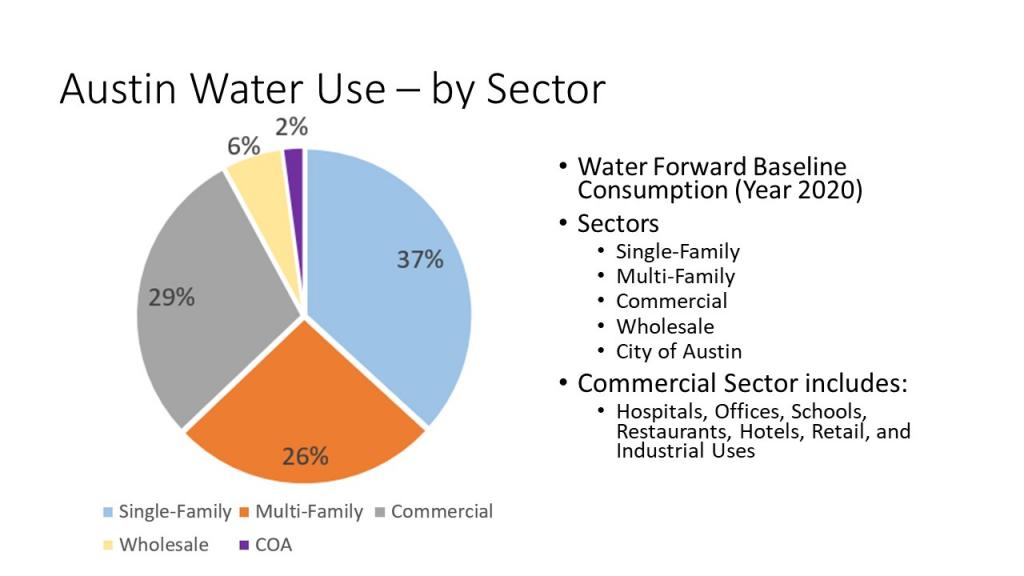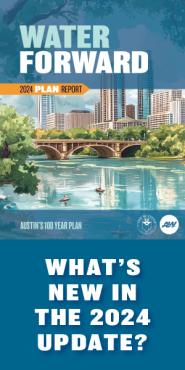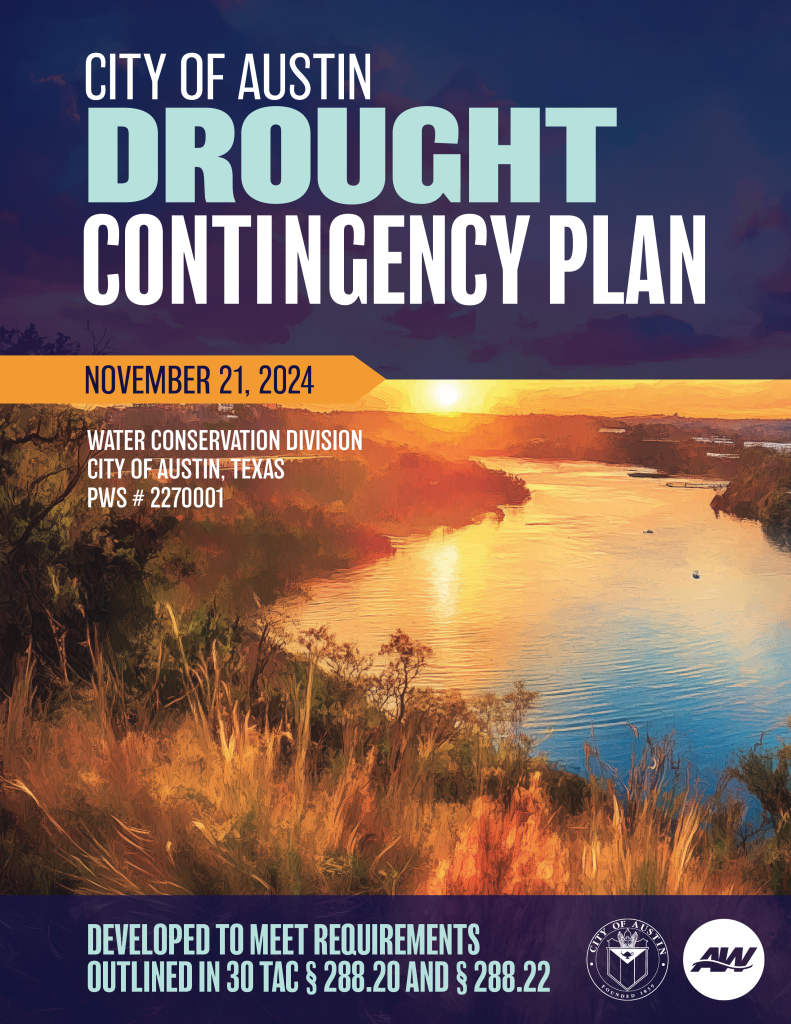Central Texas Drought
Due to recent rainfall, Austin is not currently experiencing significant drought conditions. But water conservation remains critical for Central Texas and the health of our Highland Lakes, the source of Austin's water supply. The next drought could happen at any time, which is why Austin Water keeps conservation a priority year-round. Keep reading to learn more about our drought response plans and how we've prepared our water infrastructure for these extreme conditions.
Current Drought Status
On September 2, 2025, Austin returned to Conservation Stage watering restrictions.
Stage 1 restrictions will be triggered when water storage levels reach 750,000 acre-feet. You can check LCRA’s latest projections here.
What you can do
We’re all in this together. Follow these links for more information on saving water at your home or business:
- Find Your Watering Day
- Water Conservation Rebates
- Find and fix leaks
- Sign up for alerts from the My ATX Water Customer Portal
- Water Saving Tips
- History of droughts and floods in Central Texas
-
The Lower Colorado River Basin has a history of droughts that are often broken by flooding events. For many decades, the 1950s drought was considered the worst drought on record.
More recently, the drought that spanned from late 2007 through 2015 has been declared the worst drought for our region and spurred numerous actions to prepare for future droughts.
- Three Big Changes Since the Last Drought
-
Policy makers and Austin Water staff have taken big actions based on the last severe drought. Here’s an overview of updates to our drought response and planning.
Year
Plan
Highlights
2016 Drought Contingency Plan updated and approved by Austin City Council every five years - Progressive water conservation standards, such as once per week watering year-round, goes beyond what is required by LCRA
- Gradual Steps and increasing water restrictions to manage through droughts
2018 Water Forward Plan, Austin’s 100-year integrated water resource plan approved by Austin City Council. Updated in 2024. - Includes development of new water supplies, water conservation and demand management strategies
- Strong emphasis on water conservation and the effect of climate change on our water supplies
- Plans for Austin’s population and business growth
2020 Significant updates to Water Management Plan for the Highland Lakes, approved by Texas Commission on Environmental Quality. Austin Water is a major stakeholder. - Improves methods of preserving water for cities during droughts
- Resulted in higher lake levels during this drought (more water stored)
- Used by the Lower Colorado River Authority to manage the Highland Lakes
Frequently Asked Questions
- Why are other cities in different stages of watering restrictions?
-
The State of Texas requires that all retail public water utilities with more than 3,300 connections have a drought contingency plan that is updated every five years. The Texas Commission on Environmental Quality (TCEQ) specifies the various components and drought stages of the plan, but the local utility specifies what the drought stage triggers are, as well as the actions taken in each stage to reduce water use. These considerations are based on unique aspects of each municipality, such as the source of the drinking water, water demand for that service area, and the utility’s system capacity.
Austin Water is following its Council-approved drought contingency plan that was developed with community input. It is important to note that Austin’s drought stage restrictions are more stringent than restrictions enacted in many other neighboring communities.
- Are Austin’s watering restrictions strong enough for our current drought?
-
For many years, Austin has leaned into water conservation in normal weather, as well as in drought. We adopted permanent, year-round conservation watering restrictions in 2016 that reduced watering with automatic irrigation systems to one day per week. Austin is the one of the only cities in the state to do so. The effectiveness of these conservation measures is demonstrated by our reduction of per capita water usage. In 2011, Austin Water customers used over 160 gallons per capita per day. Comparatively, the per capita usage was around 131 gallons per capita per day in 2023.
- With a growing population, will Austin have enough water?
-
Preparing for future droughts is fundamental to planning efforts at Austin Water. In 2018 Austin Water completed a 100-year integrated water resource plan called Water Forward, which was adopted by Austin City Council. Water Forward considered things that will impact our water supply, including population growth and climate change, and identified various strategies to meet our community’s water needs for the next 100 years. Implementation of the plan is underway, but we are prepared to make adjustments to respond to changing conditions. For now, Water Forward is focused on ways that new development can apply demand management and reuse strategies, as well as water supply projects to help augment Austin’s access to water during severe droughts.
- Why isn't the utility doing more to respond to the drought?
-
Austin Water is following its Council-approved Drought Contingency Plan that was developed with community input. It is important to note that Austin’s drought stage restrictions are more stringent than restrictions enacted in many other neighboring communities. Austin is currently in Conservation Stage watering restrictions, and Stage 1 restrictions will be triggered when water storage levels reach 750,000 acre-feet. You can check LCRA’s latest projections here.
- Is the City exploring other additional sources for drinking water?
-
Yes, Austin Water is in the early days of implementing additional water supply strategies from the Austin City Council-approved Water Forward plan, including Aquifer Storage and Recovery (ASR). Austin’s ASR project is currently in the study phase and is targeted to be completed around 2035. It will store water that the City currently has access to, allowing Austin to maximize local water resources. The project goal is to store 60,000 acre-feet by 2040.
- What can commercial businesses do to conserve water?
-
- Promote awareness of the need for conservation among employees and customers.
- Detect and fix any leaks. Even small leaks add up to a lot of water waste.
- Verify the irrigation system is set to current Stage 2 watering restrictions and operating correctly.
- From cooling towers to sinks, have facility staff audit water using devices to ensure they are operating correctly.
- Hire a third party water efficiency auditor and take part in Austin Water’s Water Efficiency Audit rebate.
- Take the free 3C Business Challenge to assess your facility and find out about possible upgrades and incentives.
- Review Austin Water’s Restaurant and Commercial Kitchen information and rebates.
- Review Austin Water’s information and rebates related to Businesses.
- Do parks have to follow watering restriction rules?
-
Yes, parks using City of Austin potable drinking water for irrigation must follow watering restriction rules. Auditorium Shores and Butler Metro Park use non-potable water drawn directly from Lady Bird Lake to irrigate the grounds, which is not subject to watering restrictions. Other City parks and golf courses use reclaimed, non-potable water to irrigate, which is also not subject to water restrictions.
- Can I water my home’s foundation to prevent cracking?
-
Yes, you may water your home's foundation on your assigned watering day and times. Set sprinklers to water the ground about 18 inches from the foundation.
- How can I report a watering violation?
-
Report watering violations by calling 3-1-1 or using the 3-1-1 mobile app.
- Who uses the most water in Austin?
-
Residential customers (both single family units and multi-family facilities) account for the most water use at 63%. The commercial sector that includes hospitals, schools, industrial processes and retail uses about 29% of the water available in Austin. Wholesale providers who source their water from Austin Water use 6%, and the City of Austin uses 2%.

- Are things getting better or worse?
-
The U.S. Drought Monitor tracks changing conditions across the nation on a weekly basis. You can see how things are changing in Texas over the course of the last 4-12 weeks here.




